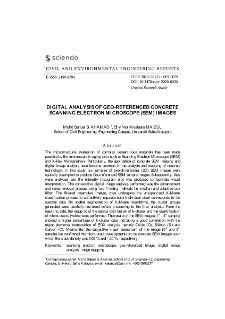Zielonogórska Biblioteka Cyfrowa udostępnia 65 391 obiektów cyfrowych
Obiekt
Tytuł: Digital analysis of geo-referenced concrete Scanning Electron Microscope (SEM) images
Współtwórca:
Tytuł publikacji grupowej:
Abstract:
The microstructural evaluation of complex cementitious materials has been made possible by the microscopic imaging tools such as Scanning Electron Microscope (SEM) and X-Ray Microanalysis. Particularly, the application of concrete SEM imaging and digital image analysis have become common in the analysis and mapping of concrete technology. ; In this study, six samples of two-dimensional (2D) SEM images were spatially resampled to produce Geo-referenced SEM sample images. Subsequently, they were analyzed and the intensity histogram plot was produced to facilitate visual interpretation. The consecutive digital image analysis performed was the enhancement and noise removal process using two filtering methods i.e. median and adaptive box filter. ; The filtered resampled images, then undergone the unsupervised K-Means classification process to collectively separate each individual pixel corresponds to the spectral data. By spatial segmentation of K-Means algorithms, the cluster groups generated were carefully reviewed before proceeding to the final analysis. From the resulting data, the mapping of the spatial distribution of k-cluster and the quantification of micro-cracks (voids) were performed. ; The results of the SEM images (1st - 4th sample) showed a higher percentage of k-cluster data indicating a good correlation with the major elemental composition of EDX analysis, namely Oxide (O), Silicon (Si) and Carbon (C). Meanwhile, the subjective visual assessment of the image (5th and 6th sample) has confirmed the micro-crack developments on the concrete SEM images upon which the crack density was 3.02 % and 1.30 %, respectively.
Opis:
tytuł dodatkowy: Prace z Inżynierii Lądowej i Środowiska
Wydawca:
Zielona Góra: Oficyna Wydawnicza Uniwersytetu Zielonogórskiego
Format:
Identyfikator zasobu:
DOI:
Strony:
Źródło:
Civil and Environmental Engineering Reports (CEER), no 30, vol. 2
Jezyk:
Licencja CC BY-NC-ND 3.0:
Prawa do dysponowania publikacją:
Biblioteka Uniwersytetu Zielonogórskiego
Kolekcje, do których przypisany jest obiekt:
- Zielonogórska Biblioteka Cyfrowa > Repozytorium > Jednostki organizacyjne > Wydział Budownictwa, Architektury i Inżynierii Środowiska
- Zielonogórska Biblioteka Cyfrowa > Repozytorium > Typy utworów > Artykuły
- Zielonogórska Biblioteka Cyfrowa > Repozytorium > Czasopisma naukowe i serie wydawnicze UZ > Civil and Environmental Engineering Reports (CEER) > Civil and Environmental Engineering Reports (CEER) (2020)
Data ostatniej modyfikacji:
6 lip 2023
Data dodania obiektu:
23 mar 2023
Liczba wyświetleń treści obiektu:
222
Wszystkie dostępne wersje tego obiektu:
https://www.zbc.uz.zgora.pl/publication/79569
Wyświetl opis w formacie RDF:
Wyświetl opis w formacie OAI-PMH:
| Nazwa wydania | Data |
|---|---|
| Digital analysis of geo-referenced concrete Scanning Electron Microscope (SEM) images | 6 lip 2023 |
Obiekty Podobne
Piontek, Marlena Lechów, Hanna Paradowska, Ewa Nycz, Marta Kuczyński, Tadeusz - red.
Nikiel, Sławomir Korbicz, Józef (1951- ) - red.
Aladwan, Zubeida Ahamad Mohd, Sanusi S. Kuczyński, Tadeusz - red.

